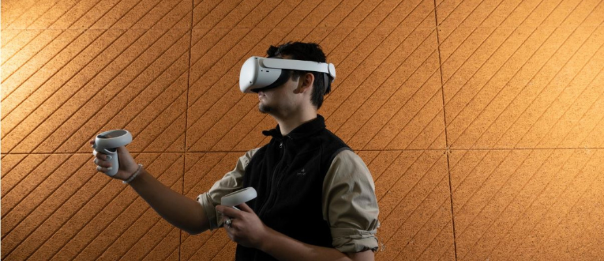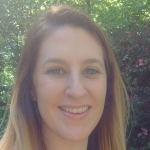
Virtual Reality Simulation in Microbiology
|
Title of case study |
Virtual reality simulation in undergraduate Microbiology |
|
Schools/Subject: |
MVLS/Microbiology |
|
Lecturer(s): |
Claire Donald |
|
Course: |
Microbiology, second year (BIOL2044) |
|
Student Level: |
Second year |
|
Class size:
|
300, 30 per session |
|
Location: |
On campus/in person |
Brief summary
Claire Donald is course coordinator of Microbiology and Immunology for second year undergraduate students. This cohort is a mix of students who are taking a microbiology course and others who are taking it as a class, not part of their degree program. Microbiology can be difficult for students to grasp concepts and connect the lecture material to real world examples. Claire therefore uses VR simulation to provide students the opportunity to better relate the lecture theory to real life studies and work situations.
Objectives
I wanted to use VR simulation as it is a developing technology that we are likely to be seeing more of in the future. I was keen to do something different that would connect with students and help them to better remember the concepts they are being taught within lectures. The VR app, which we developed alongside learning-technology specialists, provides students the chance to see and interact with microbiology at a different level to what has been possible before. This method of teaching allowed students to engage with a 3D environment, with an app specifically designed for them and this course, moving away from the 2D images of a textbook.
What is done?
The starting point for this was to produce the app for development. In 2017, a competition was launched, project Mobius, which allowed university staff to pitch ideas for the development of a VR simulation app for their course teaching. The ‘battling infection’ app was one of 10 which was chosen and developed by immersive technology company Edify, making it a bespoke and effective app for us to embed in our teaching. The university has its own VR multi-user suite at the Patrick Burgh Halls (10 minutes from campus) which is available for staff and students to use for immersive teaching.
The suite has 15 headsets and accommodates a class of up to 30 students working in pairs. To begin, the teaching staff give a short introduction to explain the context and purpose of the session, which is then followed by a brief safety demonstration where the students are shown how the headsets work. After this, one person from each pair puts on the headset and enters the app; their partner can watch what they are seeing on a computer screen connected to the headset. This is a sci-fi style game and is set in the context of a salmonella infection within a human gut, and students are required to answer questions to deal with the infection before it takes over. Once the first student has completed this, their partner will carry out the same task. Following this, staff chat with students individually about how they found the experience.
Due to the large cohort of 300 students, this needs to take place over several sessions across two days. Each class is given one hour within the VR suite which suits the layout of the class well. To date, we have not held lectures or other classes on the same day as this event.
What works well?
Students always seem to enjoy these sessions, and I often observe the enjoyment and positivity from this activity. The use of VR is something which is current and many of our students are aware of. It allows for the theory and information they have heard about in lectures to be brought to life visually and available, for them to engage with directly. Exploring the human gut is an activity which students wouldn’t get the opportunity to do without the use of VR technology which increases their engagement with the material.
Benefits
|
Students |
Staff |
|
|
Challenges
|
Students |
Staff |
|
|
What did you learn?
A lot! I have learned of the value of implementing immersive technology into my teaching and the many ways it can be used. Through working with the app designers, I have seen what is involved in the process of developing a VR app. I also learned more about students and how they can react to this sort of technology; for example, some might experience overstimulation and sickness from the immersion. I have become more aware of the apps, which have been developed across the world for a range of subjects and disciplines and how these are being used for teaching in higher education.
What advice would you give to others?
This teaching method is easily transferrable to other subjects. It may be the case that your subject already has an app through the University of Glasgow, or another university which can be used within the VR suite. The research and funding for VR as a teaching method is likely to increase and open up more opportunities for this sort of teaching to take place. Glasgow has become one of the universities on the cutting edge of VR simulation and we should be taking advantage of this.
It is difficult to develop your own app and having the idea is only the first step. The app development is not cheap and requires professional input to be an effective teaching tool. We worked with a company called Edify, who produced a good high-quality app, and through which we have gained access to other apps through connections with their other clients. It may be worth exploring whether there are students within the university who would be capable/interested in developing VR apps which could allow staff to work with them to create their own VR app for teaching use.
References
McIntyre, K., Stapleton, G., Sherry, L., Donald, C., Milling, S., Nibbs, R., Douce, G., Latkovskis, I., & McDonnell, N. (2024, April 9). ‘I felt I was there’ – can Virtual Reality (VR) enhance students’ learning experience of immunology teaching? 17th Annual University of Glasgow Learning and Teaching Conference, online. https://www.youtube.com/watch?v=eGQIS7QZmbs&list=PLUtE5AlmlvhWWPoHqsdLEapg-zqwDBZfU&index=7
Book chapter on the disease diagnostic VR app we use at Level 3:
Veitch, N. & Donald, C. (2021) Improving student engagement in the virtual world of disease diagnostics. In N. Tasler, R. O'Brien, & A. Spiers (Eds.), Being Creative in the Face of Diversity: Annual #CreativeHE collection 2021 (pp. 69-71). https://doi.org/10.25416/NTR.17709860.v1
This link is for our other qPCR VR app:
https://www.edify.ac/use-cases/disease-diagnostics-lab



